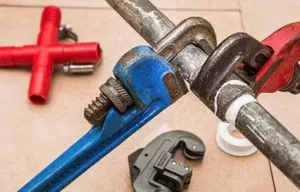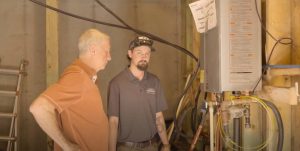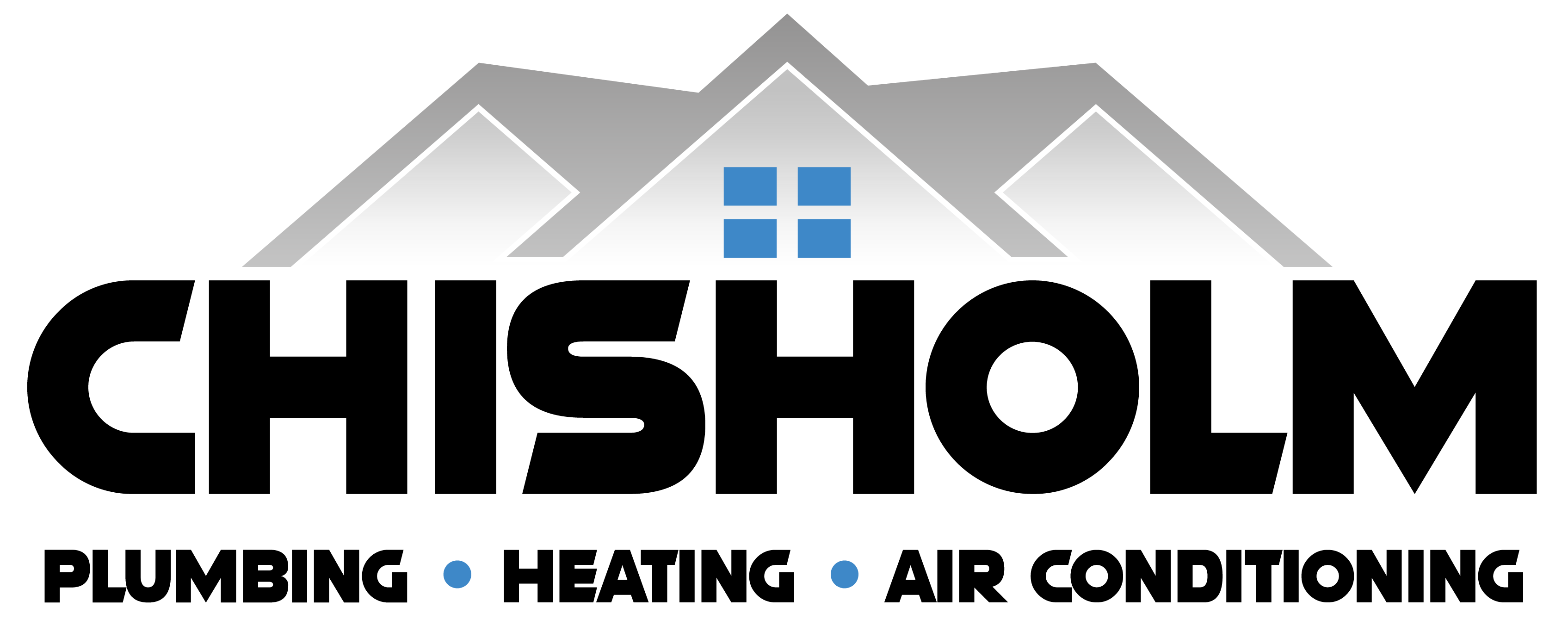In the aftermath of Hurricane Helene, our hearts go out to everyone who has lost their homes, loved ones, or sense of security. Storms like these may try to knock us down, but they will never defeat the strength of our community’s spirit. As we work together to rebuild and recover, one critical step in this process is safeguarding your home’s plumbing system from winter’s cold. With storm damage already in place, your water lines may be more vulnerable than ever, so winterizing your plumbing now is essential to avoid further damage and costly repairs.
In this blog, we’ll walk through how to winterize your plumbing after a storm, offering essential tips to protect your home’s water lines and ensure your system is prepared for the colder months ahead.
Table of Contents
| Section | Overview |
| The Importance of Winterizing Your Plumbing After a Storm | Discusses why storm-damaged plumbing is at greater risk during winter and why prevention is crucial. |
| Key Areas to Focus on When Winterizing Post-Storm | Identifies areas of your plumbing system that need special attention, including exposed pipes and water heaters. |
| Step-by-Step Guide to Winterizing Your Plumbing | Detailed instructions on how to prepare your pipes and water lines for freezing temperatures. |
| Winter Plumbing Damage: Storm Exposure vs. Prepared Systems | Presents data comparing the impact of storm-exposed plumbing to properly winterized systems. |
| FAQ: Common Concerns About Winterizing Storm-Damaged Plumbing | Addresses frequently asked questions about preparing your plumbing system for winter after a storm. |
| How Chisholm Can Help You Protect Your Plumbing System This Winter | Information about Chisholm’s services for water line protection and winter plumbing preparation. |
Glossary of Terms
- Pipe Insulation: A protective material applied to pipes to help prevent freezing during cold weather.
- Sump Pump: A device used to pump water out of basements or low-lying areas, especially important after heavy rain or flooding.
- Main Water Line: The primary pipe that brings water into your home from the municipal water supply.
- Backflow Prevention: A system designed to stop contaminated water from flowing back into your clean water supply.
- Frost Line: The depth in the ground below which the soil is unlikely to freeze, affecting where pipes should be placed.
The Importance of Winterizing Your Plumbing After a Storm
Winter is challenging for plumbing systems in the best of times, but after a major storm like Hurricane Helene, it’s even more critical to take steps to protect your water lines. Storms often leave behind hidden damage, such as weakened pipes, cracks, or soil erosion around underground lines, all of which increase the likelihood of freezing and bursting once temperatures drop.
- Storms Weaken Plumbing: Flooding, debris, and pressure from water-saturated soil can weaken your pipes, making them more susceptible to cold weather.
- Freezing Pipes Cause Serious Damage: When temperatures drop, any remaining water inside your pipes can freeze, expand, and cause the pipes to crack or burst, leading to water damage inside your home.
- Winterization as Prevention: Taking the time to winterize your plumbing after a storm can prevent future costly repairs and ensure that your home remains safe, warm, and dry throughout the winter.
If your home was exposed to the elements during the storm, or if your water lines were compromised, winterizing isn’t just a recommendation—it’s essential.

Key Areas to Focus on When Winterizing Post-Storm
Winterizing your plumbing after a storm requires extra attention to vulnerable areas. Storm exposure may have already caused some wear and tear on your system, so protecting these areas from the cold is critical.
- Exposed Pipes
Pipes in unheated areas like basements, attics, crawl spaces, and garages are especially prone to freezing. After a storm, these pipes might have been damaged or weakened, making them more likely to burst if left uninsulated. Inspect these pipes closely for cracks or leaks before applying insulation. - Water Heaters
Water heaters may have taken on damage during the storm, especially if they were exposed to floodwaters. Ensure that your water heater is functioning properly and is insulated to maintain efficiency during the colder months. - Outdoor Faucets and Hose Bibs
Any outdoor plumbing, including faucets and hose bibs, is at high risk for freezing during the winter. After a storm, it’s important to disconnect and drain these fixtures. You may also want to consider installing insulated covers to protect them from the cold. - Main Water Line
If your main water line was impacted by the storm, it could be at risk for freezing, especially if soil erosion has left it more exposed. Inspect the area around your main water line and consider having a professional evaluate its condition. - Sump Pumps
Sump pumps work hard during storms to remove excess water, but they also need to be prepared for winter. Ensure your sump pump is clean and functioning properly to avoid frozen discharge lines, which could cause backups and flooding.
To learn more about protecting specific areas of your plumbing system, visit our water and gas line services.
Step-by-Step Guide to Winterizing Your Plumbing
Here’s a step-by-step guide to ensure your plumbing system is protected from freezing temperatures after a storm:
- Inspect Pipes for Damage
After a storm, it’s crucial to check for any visible damage to your pipes, such as cracks or leaks. Damaged pipes are much more vulnerable to freezing and should be repaired immediately. - Insulate Exposed Pipes
Use pipe insulation on any exposed pipes in unheated areas. Foam pipe insulation is an affordable and effective way to prevent freezing and bursting. - Drain Outdoor Faucets and Irrigation Systems
Disconnect garden hoses, and drain water from outdoor faucets and irrigation systems. Leaving water in these lines can cause them to freeze and crack during winter. - Check Your Water Heater
Ensure your water heater is functioning properly. If your heater was exposed to floodwaters, have it inspected by a professional. Also, consider adding an insulating blanket to improve its efficiency in cold weather. - Install Frost-Proof Outdoor Faucets
If you live in a region where freezing temperatures are common, consider installing frost-proof outdoor faucets. These fixtures can help prevent freezing and bursting during winter. - Use Heat Tape on Vulnerable Pipes
For particularly vulnerable pipes, heat tape can be used to keep them warm during cold spells. Heat tape is an electric solution that wraps around pipes and provides warmth to prevent freezing. - Keep the Heat On
During cold snaps, even if you’re leaving home, make sure to keep your heat on. This will help ensure that the pipes inside your home don’t freeze.
By taking these steps, you can help prevent frozen pipes and the expensive water damage that can result from them.

Winter Plumbing Damage: Storm Exposure vs. Prepared Systems
| Aspect | Storm-Exposed Plumbing | Properly Winterized Plumbing |
| Pipe Condition | Prone to cracks, leaks, and freezing due to storm damage. | Insulated and protected, less likely to freeze or crack. |
| Water Heater Efficiency | Reduced efficiency due to flood damage or exposure. | Maintained with insulation, running efficiently in colder temps. |
| Risk of Frozen Pipes | High, especially if pipes were weakened by a storm. | Significantly lower with insulation and proper winterization. |
| Sump Pump Functionality | At risk of failure due to storm debris or freezing. | Winterized and maintained for optimal functionality. |
| Repair Costs | Higher due to potential storm and winter damage. | Lower, as preventative measures avoid costly repairs. |
Regular maintenance and winterization can prevent costly repairs, ensuring that your plumbing system continues functioning smoothly, even after storm exposure.
FAQ: Common Concerns About Winterizing Storm-Damaged Plumbing
- How can I tell if my pipes were damaged by the storm?
Look for visible signs like cracks, leaks, or rusting around your pipes. If you notice water discoloration, strange noises, or lower water pressure, it’s best to have a professional inspect your plumbing system. - Do I need to winterize my plumbing if it wasn’t damaged during the storm?
Yes, even if your plumbing seems unaffected, winterizing is always essential. Storms can weaken pipes and make them more vulnerable to freezing. - How can I prevent my pipes from freezing during winter?
Insulate exposed pipes, use heat tape on vulnerable lines, and keep your home heated, even if you’re away. Draining outdoor faucets and shutting off water to unused areas can also help. - What should I do if my pipes freeze?
If you suspect frozen pipes, turn off the water supply to prevent the pipes from bursting. You can attempt to thaw them using a hairdryer, but if the pipes are damaged, call a plumber immediately. - Should I have my sump pump serviced after a storm?
Yes, after a storm, sump pumps often work overtime, and they can become clogged with debris. Have it checked and serviced to ensure it’s ready for winter use.
How Chisholm Can Help You Protect Your Plumbing System This Winter
At Chisholm Plumbing, Heating & Air Conditioning, we understand the challenges our community faces as we recover from Hurricane Helene. Now more than ever, it’s important to protect your home’s plumbing system from winter’s freezing temperatures. Our team offers expert services in water line inspection, pipe insulation, and repairs to ensure your system is fully winterized and ready to withstand the cold months ahead.
Don’t wait until it’s too late. Contact us today to schedule an inspection or winterization service, and let us help you protect your home from costly winter plumbing damage.
